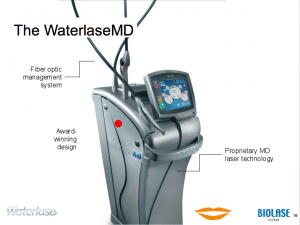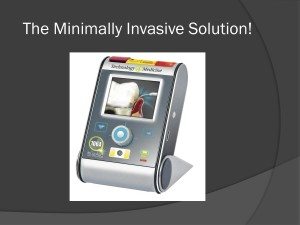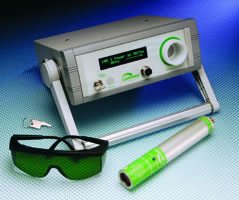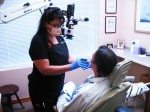



Lasers are devices that use photons of light for benevolent biologic effects. Depending upon the wavelength and the power setting, lasers can be used in a diagnostic fashion such as with the Diagnodent or they can be used in a surgical fashion to be able to gently and precisely cut both hard and soft tissues. The WaterlaseMD is a champion of lasers and performs many different tasks.
Lasers have revolutionized periodontal treatment, and have minimized the need for painful gum surgery in the treatment of periodontal pockets.Other laser types can also be used to stimulate healing. These are commonly known as Low Level Lasers or sometimes Cold Lasers. The results that we see when we involve lasers in surgical and healing treatments are quite amazing. Patients tend to have little or no postoperative pain in otherwise painful oral surgical procedures.
Laser Pocket Therapy is a more modern technique to treat periodontal pockets- deep areas under the gum that lead to bone and tooth loss. Traditionally a surgical procedure to flap the gum away from the teeth and the bones was performed along with reshaping of the bone tissue. This was a painful procedure that resulted in sensitive roots and a much more difficult environment to maintain when many foods trap between the teeth. With lasers the Gum is not removed from the tooth but the pocket is treated alongside the tooth, under the gum. The lasers are able to kill bacteria in the pockets, help clean the roots and stimulate new bone growth in some cases.
There is much less post-operative discomfort and this treatment is part of Minimally Invasive Dentistry.
WaterLaseMD is our multipurpose laser. It is capable of cutting both hard and soft tissue, as well as many other beneficial biologic effects. This laser can remove a cavity from a tooth, often times without the need for local anesthesia. It is very effective in killing bacteria and is an excellent adjunct to the conventional drill in a deep cavity or preparation. This can be the tipping point between a tooth healing or needing a root canal. There is a secondary healing effect as the laser is being used; the coherent photons of light coming out of the end of the laser are able to penetrate into the pulp of the tooth. The cells in the pulp take up the light and enjoy a biologic effect of healing, reduced inflammation and stimulation of stem cells for repair.
The WaterLaseMD is excellent in soft tissue management. It is commonly used in crown and bridge to trim unhealthy tissue that is necessary to provide a clean impression and healthy post-op healing. Patients are continually amazed at how there is virtually no discomfort, even the next day, after significant amounts of gum have been trimmed. This laser is very effective in other soft tissue applications such as biopsy. Many biopsies can be completed with only the use of topical anesthetic. The WaterlaseMD is also used to sterilize the canals in root canals and is effective in debridement of the sockets of extracted teeth, again killing bacteria and stimulating healing.
Periodontal XLase s a laser with a different wavelength -1064 nm that is specific to pigmented bacteria. These pigmented bacteria are the more pathologic bacteria that are responsible for bone loss in periodontal pockets. The Periodontal XLase is also effective at trimming soft tissue and is used to remove unhealthy tissue in the periodontal pockets. There is also a bio stimulatory effect on the cells in both the adjacent bone and soft tissue. We often use this laser in conjunction with the Waterlase MD in treatment of periodontal pockets in a procedure called Laser Pocket Therapy.
Low Level Laser Therapy promotes healing. The photons of light penetrate deep into the tissue and bone and stimulate the cells in a biological way. It encourages stem cells to differentiate into new tissue; it reduces inflammation, pain, and improves blood flow. There is no perceptible feeling of the laser on the tissue. We regularly use the low-level laser at the end of surgical treatments and very often the patients return for 2 or 3 more treatments over the next week. Patients are always pleasantly surprised that when lasers are used, there is such minimal postoperative discomfort after surgical procedures and how quickly they heal.
Finding Decay Earlier
The Diagnodent is a laser cavity detector. It uses a low-level laser signal that is beamed into the tooth. It measures the reflection (fluorescence) coming back at it, and creates a digital readout from 0 to 99. Strong healthy teeth will have very low numbers. Decay is indicated by higher numbers and exposed decay will register a 99. The Diagnodent can effectively look through the enamel and determine if there is decay underneath it. It is particularly useful in the pits and fissures on the chewing surface of a tooth. Often times the enamel is strong and hard, yet the bacteria are able to get into the inner part of the tooth through the smallest gap, and start decaying the tooth under the enamel.
This happens even though the tooth looks fine to the naked eye or to the traditional method to detect decay called dental pick or explorer. What often happens without the Diagnodent is decay goes undetected for years, and when it is finally discovered it is a big, expensive problem. The Diagnodent is one of the key tools in Minimally Invasive Dentistry. We use the analogy of the Diagnodent to radar or sonar in assessing the status of the density of the tooth. Early caries detection is coupled with conservative restoration using Air Abrasion in saving the strength of a tooth for a lifetime. Who would like to catch decay early and save the strength of the tooth?
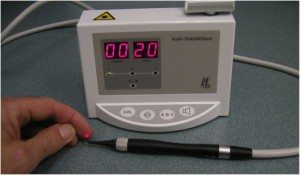
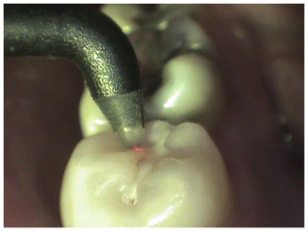
The Red Laser is a laser with a visible wavelength that is most effective on soft tissue and epithelium.

